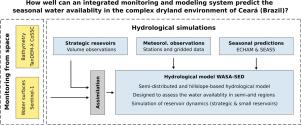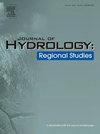Regional-scale seasonal forecast of surface water availability in a semi-arid environment: The case of Ceará State in Northeast of Brazil
IF 4.7
2区 地球科学
Q1 WATER RESOURCES
引用次数: 0
Abstract
Study region:
Ceará (Brazil).
Study focus:
Considerable intra- and inter-annual variability of rainfall in this semi-arid region lead to strong temporal variations in water availability. To store and supply water in times of water scarcity, tens of thousands of freshwater reservoirs have been built over time, most of which are unmonitored. Here, we develop a hydrological forecasting system for the entire state of Ceará which integrates satellite-based monitoring of reservoir water storage, bias-corrected seasonal weather forecasts and hydrological modeling of freshwater availability. We test and demonstrate the applicability of this system by conducting experiments with historic data, hindcasts and forecasts.
New hydrological insights for the region:
The assimilation of in-situ and Sentinel-1 based observations of reservoir fillings into the hydrological model WASA-SED proved to be feasible and an important step in the modeling of available water resources dynamics. Hydrological simulations for January to June from 1990–2019 based on meteorological observations resulted in a median average NRMSE between observed and modeled reservoir fillings of strategic reservoirs of 29.51%. The comparison of observed and predicted precipitation from two different seasonal forecasting systems were in the same order of magnitude (i.e. 19.51% and 24.52%). Hindcast experiments suggested the superposition of uncertainties of different model components. Efforts are currently being made to further test and improve the developed integrated framework as part of the operational service.

半干旱环境中地表水供应的区域尺度季节性预测:巴西东北部塞阿拉州的案例
研究地区:塞阿拉(巴西)。研究重点:在这一半干旱地区,降雨量的年内和年际变化很大,导致可用水量在时间上变化很大。为了在缺水时储存和供应水源,长期以来建造了数以万计的淡水水库,其中大部分水库都没有受到监测。在此,我们为整个塞阿拉州开发了一套水文预报系统,该系统集成了基于卫星的水库蓄水监测、偏差校正季节性天气预报和淡水可用性水文模型。我们通过对历史数据、后报和预报进行实验,测试并证明了该系统的适用性。对该地区的新水文见解:事实证明,将基于原位和哨兵 1 号卫星的水库蓄水观测数据同化到水文模型 WASA-SED 中是可行的,也是可用水资源动态建模的重要一步。基于气象观测数据对 1990-2019 年 1-6 月的水文模拟结果表明,战略水库的观测水库蓄水量与建模水库蓄水量之间的平均无显著性差异(NRMSE)中位数为 29.51%。两个不同季节预报系统的观测降水量和预测降水量的比较结果处于同一数量级(即 19.51% 和 24.52%)。后报实验表明,不同模式组成部分的不确定性是叠加的。目前正在努力进一步测试和改进所开发的综合框架,将其作为业务服务的一部分。
本文章由计算机程序翻译,如有差异,请以英文原文为准。
求助全文
约1分钟内获得全文
求助全文
来源期刊

Journal of Hydrology-Regional Studies
Earth and Planetary Sciences-Earth and Planetary Sciences (miscellaneous)
CiteScore
6.70
自引率
8.50%
发文量
284
审稿时长
60 days
期刊介绍:
Journal of Hydrology: Regional Studies publishes original research papers enhancing the science of hydrology and aiming at region-specific problems, past and future conditions, analysis, review and solutions. The journal particularly welcomes research papers that deliver new insights into region-specific hydrological processes and responses to changing conditions, as well as contributions that incorporate interdisciplinarity and translational science.
 求助内容:
求助内容: 应助结果提醒方式:
应助结果提醒方式:


